MACHU PICCHU
“the Old Mountain”
We began this Vermont Bike Tour with with two outstanding trip leaders: Jorge Luis Olivera Berrio and Sergio Eduardo Prieto Santisteban both from Cuzco. Their enthusiasm and knowledge of their country was amazing. We were so fortunate to share their knowledge of history and love for their heritage. It was contagious.
We were a group of 18, meeting in Cusco: three couples were from Canada, and four couples from the US, one a family with two young adults.
The information in this blog is from our trip leaders as well as the book below.
(Saudi M. Negro Romero, Presenting Peru and Machu Picchu, Sixth Edition, 2019).
VBT strategically planned a gentle altitude climatization by introducing to hiking daily.
The average daily mileage was 4-8 miles, average hiking time 2-6 hours. The average high/low temperature in Cusco was 68/31 degrees F (Southern Tropical Zone). We had no precipitation.
Peru has a population (2017) of 31,237,385 inhabitants. Population density is 24.6 inhabitants/square km. Over 60% of Peruvians are under 40 years old. Life expectancy at birth (2015-20) is an average of 75 years. The total fecundity rate is 2.22 children per woman. It is the third largest country in South America And divided into three regions: coast (10%), Andes (30%), rain forest (70%) connected by roads From the Atlantic and the Pacific coasts.
Peru was formed as a result of the Nazca and South American tectonic plates. The Andes Mountains and glaciers resulted 80 million years ago from the plate shifts. Global warming has been identified (National Geographic Institute) as causing 41% of glacial ice loss. Peru’s White Cordillera has lost 37% of its everlasting ice caps. Peru possesses 18 mountain ranges and 3,044 glaciers.
Peru is a Constitutional Democratic Republic with a multiple political party system. Voting is personal, free, equal secret and mandatory up to the age of 70 (optional after that). Peru’s Date of Independence was July 28, 1821.
Syncretism is the Andean religion around which many festivities are celebrated. Peruvians are a mix of Catholic and Secretism. Their devotion to Mother Earth (Pacha Mama), Mother Moon (Mama Killa), Father Sun (Inti Tayta), and water (Mamaqocha) was based on the belief that all things have a spirit. Much of their art reflects their gods, leaders, symbolic animals and life philosophy.
The puma (strength, power, courage, secrecy and dexterity) the serpent (symbolized as fertilizing water) and the condor (sense and wisdom, messenger of the gods and mediator between gods) are referred to often.
2017 census reports 75% of the population is covered by some kind of health insurance. Approximately 80% have access to public electricity, sewage and drinking water networks.
Peruvians are proud of the fact that they have no slavery nor poverty. They are very industrious and dislike “laziness”. In Inkan times, there was no money, market, commerce, accumulation of wealth or taxes as we know it today. There was no iron or slavery, no currency, wheels, alphabet or writing systems. They cherished three concepts: magical, astronomical and religious. They held dear three principals: don’t be lazy, don’t lie, and don’t steel. Inca wisdom revolves around a four sided philosophy is TAWAN, TIN AND SUYU as depicted in the Chakana or Andean Cross.
Earthquakes, and the El Niño Phenomenon have caused major disasters. Much of Peru is inside the fire ring and tremors are a daily occurrence. River swells, avalanches, landslides, floods, draughts and frosts cause less serious impacts. Normal rainfall during the rainy season is 70 inches. However in 2000, the rainfall was 140 inches and helicopter evacuation was required.
The currency is the Nuevo Sol divided into 100 centimes and circulates in bills and coin. Peruvian 🇵🇪 Cusco 🏳️🌈flags.
Economy
Their natural resources were the cause of their exploitation by other countries (copper, gold, lead and iron) have contribute half of Peru’s exports. Tourism is a renewable fourth involving the ANP (Natural Protected Areas).
Their main exports are fish meal, fish, oil, cotton, sugar, coffee, mining of minerals, petroleum and its byproducts and natural gas. addition, alpaca fiber, anchovies, asparagus, bananas, honey, butterflies, ceramics, cereals, cochineal, chilies and spices, medicinal herbs, flowers, chocolates, giant corn and purple maize, guinea pigs. Grapes, handicrafts, jewels, citrus, Pisco, prawns, olives, potatoes, quinoa, seal algae, horses, shoes, textiles, trout, turkeys, and wines.
As elsewhere, Rainforest Deforestation, logging & overgrazing, foreign land ownership, industrial waste and water pollution are major concerns. Foreign species of trees (eucalyptus) were introduced and found unsuitable.
As elsewhere, Rainforest Deforestation, logging & overgrazing, foreign land ownership, industrial waste and water pollution are major concerns. Foreign species of trees (eucalyptus) were introduced and found unsuitable.
Inca History
During the Inkan times, a very organized polyethnic social structure (Ayala) developed with royalty, nobility and popular classes. The Inca was a semi-divine being with exceptional wisdom and powers to rule and give welfare and security to his people. Education was a formalized system reserved for the elite without the need for formal writing. Studies included religion, spirituality, astronomy, engineering, medicine, accounting history, etc.
In 1527 #11 Huayna Capac died of the smallpox epidemic after dividing the empire in half to his two sons Atahualpa (Quintan Mother) and pure blooded Cuzquenan Huascar. Civil war ensued and the downfall of the Incas began.
In 1526 Spanish Francisco Pizarro heading from Panama discovered the rich settlements of the Inca Empire & returned to Spain to resupply for the destruction beginning on Ecuadorian coast to Cajamarca, Peru in 1532. Atahualpa was captured & thousands of unarmed tribesmen killed. Pizarro murdered Atahualpa after offering gold & silver stripped from the walls of Qorikancha after holding him in prison. The Spanish Army was unstoppable (mounted horseback with armour and swinging steel swords). The Inca Empire disappeared into the mountains & jungles.
1535 Pizarro founded Lima and was assassinated in 1541 by the son of Diego Almagro, who had been put to death in 1538. Manca Inca nearly regained control of the highlands in 1536, but retreated to his hideout in Vilcabamba in 1539 and was killed in 1544. Inca Tupac Amaru fought the Spaniards but was executed in 1572.
For the next two centuries, natives were captured as slaves.
High taxes imposed by Spain & the desire to control Peru’s rich mineral deposits led to rebellion in 1800s. Help came from Jose De San Martin who proclaimed Peru’s independence in 1821 after liberating Argentina & Chile from Spain. Simon Bolivar did the same for Venezuela. Columbia & Ecuador and the Spanish surrendered in 1826.
Education, based on good examples, made the Inkan people cultivated. Virtues like hard work, veracity, honesty, empathy, respect peace and joyfulness were inculcated. Inkan economy was agriculture and the administration of abundant production using animal breeding, fishing, and textile work and a food conservation and storage system using an interconnected road network made the Andeans successful. Their work system used the principals: AYNI (a barter system, reciprocity of services given and received), MITA (work performed in rotating shifts using individual’s skills and capacities as a form tax payment), and MINKA (tasks performed for a common benefit, all together).
The Andeans built 328 temples honouring three gods: the sun, water and Mother Earth and their strong connection to life. Many of these temples no longer exist. Many stones were stolen and used to build churches, and only 20% still exist. The Spanish monks recognized Incan pagan idolatry stripped the gold and destroyed many of the temples.
Machu Picchu was worked on for 86 years and it was far from finished. It was protected 360 degrees by the mountains. 70% of the foundations are underground. There were 700 inhabitants and workers camped outside of Machu Picchu which rotated every three months. This work paid the taxes to the Inca in exchange food, clothing and housing. In 1871 the last Inca was executed.
Great astronomers studying the cosmos and its laws created agricultural and religious ceremonial calendars. They regarded the Milky Way with a Shepard, a Fox, the Llama with her offspring, the Partridge, the Snake and the Toad. Their calendar evolved around the winter and summer solstice with big celebrations for each.
Inca Trail is Peru’s best known hike, combining a stunning mix of Inca ruins, mountain scenery, lush cloud-forest and rich subtropical jungle. The Inca Trail is a mountainous jungle hike leading to the sacred Inca city of Machu Picchu (8,000ft of challenging hiking.
Description of Tour
Day 1 we began at 13,790 ft visiting the Cuyuni Community with a privileged view of the Villanova mountain range. We saw the highest mountain of Cusco, the Ausangate (21,000 ft) considered one of the most important deities in the area.
We were greeted by the Cuyuni Villagers and taken to a place where the priest prayed for our safety and health and burned offerings.
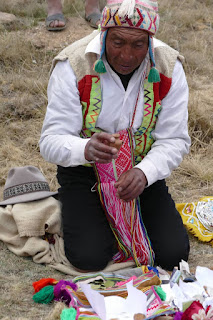


The children were beautiful and the ladies wool dresses very colourful.


The women were busy demonstrating portable weaving techniques and afterwards a display of their Dyed wares along with the plants used.
We were greeted by the Cuyuni Villagers and taken to a place where the priest prayed for our safety and health and burned offerings.



The children were beautiful and the ladies wool dresses very colourful.


The Cuyuni shelters about 60 families and are dedicated to agriculture, textiles and craftsmanship. Lunch was at the Village of Pisac, where we learned the difference between an Alpaca and llama Demonstrated their fiber crafts (dying, carding, washing, weaving and their music and dancing.
Day 2
Village of Chinchero is another typical Andean Village with Inca Ruins, Colonial Church, and beautiful landscape. We descended to the Village of Uquillo (9,777 ft) best known for the haciendas dating from the Colonial Period.
We were presented with a ceremony for safe passage by the local priest & his partner, who burned many symbolic herbs to insure our safety.
Afterwards we were treated to a demonstration of the use of drop spindle, weaving using on hand pieces of wood, ways wool is used in the mountains, and finally a dying demonstration and education about the different kinds of wool producers. The tops of the women’s hats are very ornate.

Beautiful children
Photos with traditional dressed women and their baby alpacas could be had in exchange for a few Solas.
We were presented with a ceremony for safe passage by the local priest & his partner, who burned many symbolic herbs to insure our safety.
Afterwards we were treated to a demonstration of the use of drop spindle, weaving using on hand pieces of wood, ways wool is used in the mountains, and finally a dying demonstration and education about the different kinds of wool producers. The tops of the women’s hats are very ornate.

Beautiful children
Photos with traditional dressed women and their baby alpacas could be had in exchange for a few Solas.


We visited Chinchero with Andean ruins, Colonial Church and markets.


We enjoyed a wonderful hike and Personally appreciated the variety of wild flowers found in “tundra” like conditions.
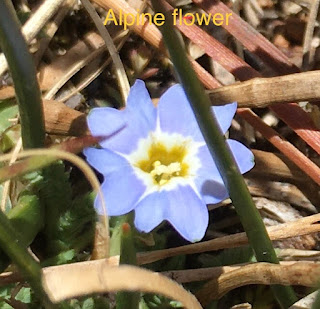


We visited a Chincheria where chi cha de Jora (corn beer) is prepared. We sampled chicha and cuy, (roasted guinea pig) National dish of Peru. We even learned “playing Sapo”a toss game Popular in Europe and Peru. El Sapo is known for it’s mystical power. In Inkan times, if the frog caught the gold piece in it’s mouth, the person would be instantly rewarded with a wish.
I admired the imaginative recycle bins in Agua Calientes, maybe rewarding people who used it properly with a wish?!







Day 3 we visited the Qotowincho Market in Urubamba, the largest town in the valley. Amazing 4,300 varieties of potatoes, corn and fruit due to it’s many micro climates. Peru lies at 13 degrees South and because of its closeness to the Equator has a timberline of 14,000 ft. They use their land for agriculture and smaller, less destructive animals to their environment, such as the guinea and alpaca. There are almost no cattle. The bounty of the markets were phenomenal!



These hats provide some cooling chambers for women with thick braids.


Andean cheese, very delicious.

And then there were flowers! Purple corn is prized!


Afterwards we hiked to the Maras Salt Mines (11,082 ft). More than 3,000 salt ponds or flats have been worked since before Inca times. The mines are fed by underground saltwater springs to Maras village. The terraced salt pans of the Salineras are still mined using methods unchanged over centuries. This salt is considered the highest quality and is stored in huts for sale.


Our visit to the mines was accompanied by the most beautiful Peruvian flutist and We are enjoying this music on our return (a treasured memento).
This, followed by a sumptuous picnic lunch provided by Cicciololina’s catering overlooking Huaypo Lagoon. The Menu: Welcome Pisco Sour, Chicha Morada with fruit, wine, beer, beets & wild potato chips with avacado & smoked trout dip with wasabi.



Composing Multigrain bread with cream cheese



Composing Multigrain bread with cream cheese
Grilled chicken pieces with roasted and cherry tomatoes
Avocado and arugula drizzled with rustic pesto dressing.
Big corn pinches with Huancaina salsa and grilled local cheese.
Mini roasted vegetable and white wine quiches.
Native and sweet potato chips with creamy yellow chili salsa.
Roast beef of Alpaca slices with seeded mustard and sweet aguaymanto spread.
BBQ’d red trout with coconut and lemongrass sauceserved with grained quinoa and mushrooms.
Jungle chocolate Mousse
Fresh strawberries
Sticky banana cake
Wild herb Teas and Plunged Quillabamba Coffee
After this feast we enjoyed an optional walk around the 85 hectares of Yucay terraces, the Inca irrigation channel still in use and some petroglyphs and hillside burial grounds.
Farming is still done using traditional methods of oxen and manual labour today.
We were in many beautiful lodgings but our favourite was Hacienda Urubamba in the Sacred Valley.
Our fellow hikers carried a pulse oximeter and an altimeter which indicated how aware our bodies were of the altitude change.
Peru National Parks comprise an area equal to the size of Switzerland. There are still people living in the rain forest with no interaction with others. These Andeans have hemoglobin adapted to the altitudes and live happily in their environment. we were offered coca leaves and tea everywhere, considered magical and sacred as useful adjustment to altitude. It contains daily essential minerals and elements, as well supposedly an anesthetic which mitigates fatigue, hunger and thirst. The effects of chewing coca are not to be confused with cocaine absorbed via other means.
Acid is extracted from the female cochineal and treated to produce carmine, which can yield shades of red such as crimson and scarlet. The body of the insect is 19–22% carminic acid.


Machu Picchu is an impressive Inca Citadel placed on the side of a mountain. It was never mentioned by colonizing Spaniards (Conquistadors). It’s Quechua name means “Old Mountain” but it was also known as the “Lost City of the Incas”.
It was built in the fifteenth century and is attributed to the Inca Pachacutec. It was built in the flanks of two hills belonging to the eastern mountain range of the Andes, descending into the Amazonian upper sylvan. It is extraordinary example of architecture and engineering.
It remained hidden from the West until discovered by Hiram Bingham in 1911 while searching for Vilcabamba. He “borrowed artifacts which he deposited in Yale U’s Peabody Museum with the intention of doing research for 12 years. They were never returned.


Day 4 Inca Trail
Only a certain number of permits are issued daily in advance to avoid too many on the very narrow trail. All hikers are accompanied by at least two trip leaders and a “Sherpa” to carry the water and lunch supplies, emergency equipment.
There are many approaches to the Inca Trail. Neice Mary joined a group which walked and camped at designated sites for a week before reaching Machu Picchu with help from Sherpas to carry camp gear and food.

There are many approaches to the Inca Trail. Neice Mary joined a group which walked and camped at designated sites for a week before reaching Machu Picchu with help from Sherpas to carry camp gear and food.

The narrow-gauge Ollantaytambo Vistadome train stops at “Km 104” for the start of the 8 miles or approximately 6 hour hike. There are no washrooms, or water stations along the way. Hiking poles were beneficial.


Disembarked at the “Km 104” marker (7,183 ft) to start one of world’s most iconic walks amid the cloud forests surrounding Machu Picchu.
Intipunku, the Sun Gate (8,954 ft) was the original entrance to the “Lost City”, the most spectacular approach to Machu Picchu from above. This lovely photo provided by our Neice.



Stone stairs leading to the Sun Gate.
Thank you Mary for these great photos.

Winaywayna (Forever Young) is a higher peak of beautiful terraces and landscape.



Stone stairs leading to the Sun Gate.
Thank you Mary for these great photos.


Winaywayna (Forever Young) is a higher peak of beautiful terraces and landscape.
Inkan “hanging bridge” Over the Rio Urubamba
Ollantaytambo
Waynapicchu, the young mountain.
Day 5 Macchu Picchu Historical Sanctuary
The Peruvian government regulates MP’s historical site and restricts visits. We enjoyed our visit to our Hacienda Agua Calientes, set in a rain forest along the river.


Our time to visit Machu Picchu was an 11:00, so we enjoyed Birding by a naturalist on Agua Calientes Hotel trails with an ornithologist. We were treated to viewing Peru’s national bird, cock of the rock. The male exhibits a brilliant red plummage and his mating dance very entertaining.


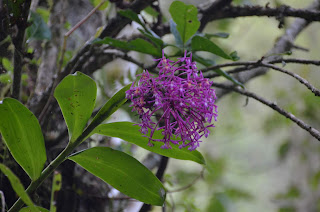

 Unusual varieties of orchids?
Unusual varieties of orchids?


The sides of Machu Picchu hold an urban and agricultural sector. The urban consists of the Temple of the Sun, the Intihuatana or solar clock and calendar, the Temple of Three Windows, the Main Temple and the Condor Sector.





The building techniques are precisely varied depending on the materials used designed to withstand the passage of time, earthquakes and torrential rains done with ingenious rolling logs, stone nails, ladders, interlocking stones and teamwork.

Two over one, one over two construction with locking corners. The foundations, underground and water canals and represents half of the construction total work. They brought soil and clay to fill the benches terraces for agricultural use. The springs are great underground water reservoirs supplied during the rainy season.
The Sacred Stone, below is impressive monolith of carved stone, 10 ft high and 23 ft wide. It conforms to the mountain behind it.


Stones from great distances were used with different qualities and techniques, most impressive is the Main Temple with perfectly fitted stones.
They knew exactly where to look for the winter solstice, equinox and other significant events and built their agricultural plans around them.
Today we visited ruins which were historically important religious temples. Jorge, our wonderful Trip Leader, guided us around the remnants of Incan Empire monuments and impressive ruins.


Our time to visit Machu Picchu was an 11:00, so we enjoyed Birding by a naturalist on Agua Calientes Hotel trails with an ornithologist. We were treated to viewing Peru’s national bird, cock of the rock. The male exhibits a brilliant red plummage and his mating dance very entertaining.




 Unusual varieties of orchids?
Unusual varieties of orchids?

The sides of Machu Picchu hold an urban and agricultural sector. The urban consists of the Temple of the Sun, the Intihuatana or solar clock and calendar, the Temple of Three Windows, the Main Temple and the Condor Sector.





The building techniques are precisely varied depending on the materials used designed to withstand the passage of time, earthquakes and torrential rains done with ingenious rolling logs, stone nails, ladders, interlocking stones and teamwork.

Two over one, one over two construction with locking corners. The foundations, underground and water canals and represents half of the construction total work. They brought soil and clay to fill the benches terraces for agricultural use. The springs are great underground water reservoirs supplied during the rainy season.
The Sacred Stone, below is impressive monolith of carved stone, 10 ft high and 23 ft wide. It conforms to the mountain behind it.


Stones from great distances were used with different qualities and techniques, most impressive is the Main Temple with perfectly fitted stones.
They knew exactly where to look for the winter solstice, equinox and other significant events and built their agricultural plans around them.
Day 6 Peru Walking Day
Today we visited ruins which were historically important religious temples. Jorge, our wonderful Trip Leader, guided us around the remnants of Incan Empire monuments and impressive ruins.
Tambomachay 12,500 ft) fulfilled an important religious function linked to water and regeneration of land.
Fortress Sacsayhuaman fortress (pronounced “sexy woman”).
Only a fraction of it’s original massive size and shape of the megaliths, some of which weighed 90-128 tons. There are outlines of a llama in stone here. It is the best known ruin nearby Cuzco, likely a religious construction for cosmology veneration and investigation.
Puka Pucara is a military construction composed of large walls, terraces and stairs to defend Cuzco.
Lago was a ceremonial cave with several stone carvings of pumas, serpents and monkeys.
Qenqo was a Center dedicated to ritual and includes semi circular amphitheatre and underground galleries.

Day 7
Return to Cusco through the Sacred Valley by train and explored this ancient Inca capitol captured by the Spanish Colonial Conquistadors in 1553 as we explore Koricancha (“Temple of the Sun”).



Fashion show, music and dancing Provided on this train!

Return to Cusco through the Sacred Valley by train and explored this ancient Inca capitol captured by the Spanish Colonial Conquistadors in 1553 as we explore Koricancha (“Temple of the Sun”).




San Blas district, is a settlement for ancient craftsmen who saw “yachay” (Quechua for “teach & learn”) as their calling.
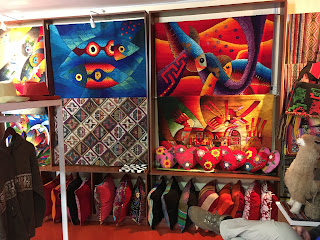

Peruvian Retablos are traditional wooden them boxes made by artists in the mountains.

 My favourite
My favouriteWe received a lesson about the different alpaca products on the market from an alpaca connoisseur, who tells us “the price is telling you” the type wool. There is baby alpaca, adult alpaca and maybe alpaca. Llama is a camel descendant (taller, longer neck and less fine wool).

Tambomachay (Inca’s Bath ) ceremonial bath (12,500).

Pukapukara “red fort ruins or hunting lodge, guard post or stopping point. Upper esplanade panoramic views

Pukapukara “red fort ruins or hunting lodge, guard post or stopping point. Upper esplanade panoramic views
Day 8 Walking Trails in the Sacred Valley
The Cusco Cathedral and the San Blas district were built on top of an Inca Temple.
San Blas Church is an unusual Baroque-style church of many artists and artisans. The Spaniards hired the Andeans as artists, scupturers and woodcraftsmen. The paintings of the pregnant Madonna and the Last Supper reflect th
Parading with the Black Jesus, celebration and feast follows honouring the beneficence of the wealthy donor.
Koricancha (Temple of the Sun) and then Convent, Church and Monastery Santa Dominga
“It is not the strongest of the species that survives, nor the most intelligent that survives. It is the one that is most adaptable to change.
—PHILIPPE DE CLERMONT,
OFTEN ATTRIBUTED TO CHARLES DARWIN”
Many thanks to Mary, Mark and Persephone for their wonderful photos!












































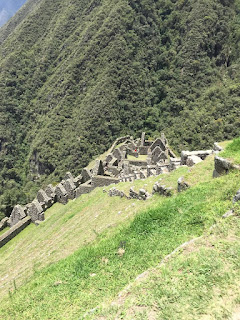








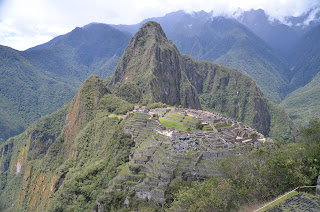

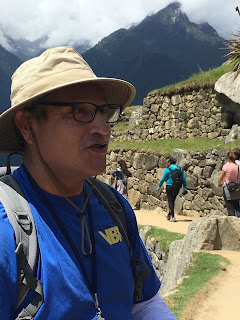





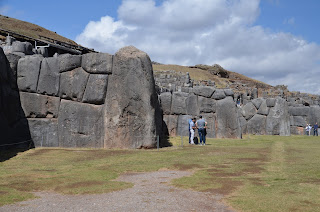
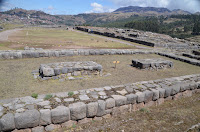







No comments:
Post a Comment